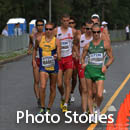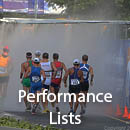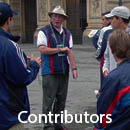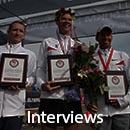CARL SCHUELER
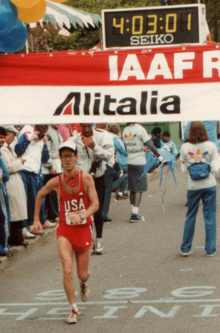
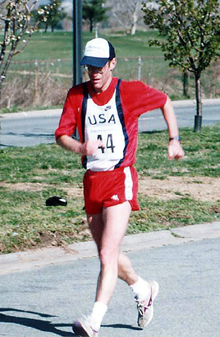
Birthday: February 26th, 1956
Current Residence : Colorodo Springs, CO
Hometown: Ann Arbor, MI
College: Frostburg College
PRS
Outdoors
20 km - 1:25:04
50 km - 3:57:09
Talking with Carl Schueler, you would never guess what a fierce competitor he once was. Synonymous with success as a distance walker throughout the 1980s and into the 1990s, Schueler displays a laid back attitude that can mislead you. The four-time Olympic Games qualifier had a long and successful career race walking, while balancing a real career and life outside of race walking.
Carl Schueler may have started race walking with the biggest and shortest splash in race walking history. While a 9 th grader at a four-year Catholic high school in Ann Arbor, Michigan, Schueler was running a workout. He was told to jog the curves and run the straight-aways, but he was having trouble. His coach mocked, “You’re race walking,” challenging him to a quarter-mile race. Schueler walked a 1:58. Assuming his technique was legal, the performance must be some kind of unofficial record. Even if it was not legal, it’s impressive that anyone could even come near race walking so fast on their first attempt.
Schueler’s initial race walking career fizzled out as quickly as it started. He graduated high school and attended Frostburg State College, a small school in Maryland, where he ran cross country and track before becoming injured his sophomore year. When he noticed that the NAIA Frostburg included race walking on its board of events, he became intrigued. Schueler had not race walked a step since his first experience in high school. As his good fortune would have it, a teammate had a minor interest in the sport. He wasn’t very good, but he introduced Schueler to Bob Kitchen, Sal Corrallo, and the rest of the race walking community. Training mostly on his own, Schueler achieved a 7:09 mile by Christmas of 1975.
Realizing that his quarter-mile experience was not a fluke and that his talents lay more with race walking than running, Schueler trained for the NAIA Indoor Nationals. In February of 1976, Schueler finished second behind Jim Heiring, just a few short months after he had started to race walk.
Schueler continued to progress, winning the 25K at what in those days was called a B Championship. B Championships were similar to what Larry Young called Junior Championships. You could compete only if you had not won a Senior national title. As Schueler humbly recalls his success, “I won those kinds of things.” Those kinds of things also included a trip to compete at Mexican Walk Week in 1977 and Swedish Walk Week the following year.
Graduating college in 1978, he began working for the U.S. Department of Defense. By 1979, he had walked five 50K races—none all that fast, according to Schueler. At the World Cup he seemed as if he was going to have a breakthrough. On four-hour pace for most of the race, he unfortunately faded badly at the end, finishing in a time of 4:27:24.
Deciding to focus his energies on the Olympic Trials, in January 1980 Schueler arranged to work four-hour days and train the remainder of the time. He quickly became a lot faster. In less than six months he improved his 50K time from 4:24 to 4:06. Putting it all together at the 50K Olympic Trials of May 1980, Schueler walked an impressive 3:59:33. While he had sacrificed in his career, essentially training full time, he was not rewarded. The U.S. boycotted the Olympics. Schueler also raced at the 20K Olympic Trials, but had not yet perfected the 20K distance and thus finished sixth.
After the Trials, he temporarily retired from race walking and entered a graduate program for regional and urban planning at the University of Michigan. Not training, he did join the occasional Alongi Invitational. After finishing all but his practicum in 1983, Schueler had nothing else to do, so in the spring he began working out again. He trained in Ann Arbor that summer, and then in September moved to Colorado Springs for an opening in a residence program at the USOTC. At that time, specific time standards weren’t required to be a resident; he was accepted on his past credentials.
The training center environment proved beneficial for Schueler. Although he claims to have mostly self-coached, he acknowledges receiving a lot of physiological help as well as other assistance from numerous people, then and over the years.
Going into the 1984 Olympic trials, Schueler was the man to beat. He had won the National 35K with a very fast 2:41, but then had a terrible race at the Trials. He became dehydrated and lost to fellow residents Marco Evoniuk and Vinny O’Sullivan. Fortunately, Tommy Edwards just didn’t have enough speed to catch him.
At the Olympic Games in L.A., Schueler showed why he had been the favorite at the trials. Under very hot conditions, competitors kept dropping out around him. It was a war of attrition. As the race went on, hopes rose for an American medal. Schueler finished sixth, just two minutes away from fourth place. America had been one DQ and two minutes away from its first Olympic race walking medal in years.
Schueler pretty much took 1985 off and, as a testament to his amazing ability, still won the National 50K, “Drinking beer, hanging around, and working full time,” as he puts it. (I am sure somewhere in there he managed to get in a walk or two.) His success was contagious. In 1986, Schueler met his future wife, Debbie Van Orden, and infected her with the race walking disease. He likes to think of it as his curse.
Shortly after, Reebok and Rockport started sponsoring walking. With more money pouring into the sport than ever, Schuler started to train again. Wanting to give up the 50K for a while, he focused instead on the 20K. In 1986, he established his 20K PR of 1:25:04. However, he was soon back to the distance that proved so successful for him, racing the 50K at the World Track and Field Championships in Rome. He set his PR of 3:57:09 at that event.
As the 1988 Olympic Trials approached, Schueler again turned up the effort. He returned to working part time, this time six-hour days. This break from work proved enough to get him in “very strong shape.” He won the Trials, but at the Olympics didn’t place anywhere near as high as before. The combination of international race walkers getting faster, the additional walkers returning after the 1984 Games boycott, and a respiratory problem lead Schueler to finish twenty-third. He thought he was in 3:52 shape, but felt flat and walked 3:57:44.
1992
9th - 1:29:57
1990
3rd - 1:28:21
1989
4th - 1:28:22
1988
3rd - 1:31:39
1987
2nd - 1:26:10
1986
2nd - 1:25:04
1985
8th - 1:32:25
1984
5th - 1:29:55
1983
8th - 1:29:04
1980
5th - 1:30:26
1979
8th - 1:35:39
1978
10th - 1:35:39
1997
5th - 4:19:46
1995
3rd - 4:06:45
1992
1st - 4:01:51
1991
1st - 4:06:21
1988
1st - 3:57:44
1987
1st - 3:57:09
1985
2nd - 4:13:14
1984
1st - 3:59:46
1983
8th - 4:15:56
1980
1st - 3:59:33
1979
5th - 4:24:16
1978
3rd - 4:29:22
None
1992
50K - 4:02:10
50K Olympic Trials - 4:02:10
1991
50K - 4:11:03
1988
50K - 4:02:55
50K Olympic Trials - 3:57:48
1987
50K - 4:00:19
1986
30K - 2:29:02
25K - 1:43:28.0
1985
30K - 2:26:17
40K - 3:15:04
50K - 4:18:07
1984
35K - 2:41:26
40K - 3:13:57
50K - 4:07:23
1983
40K - 3:14:03
1980
50K - 4:06:07
50K Olympic Trials - 3:59:33
50K Olympic Games
1992 - 23 rd - 4:13:38 - Barcelona, Spain
1988 - 23 rd - 3:57:44 - Seoul, Korea
1984 - 6 th - 3:59:46 - Los Angeles, USA
50K World Championships
1991 - DNF - Tokyo, Japan
1987 - 16 th - 3:57:09 - Rome, Italy
50K World Cup
1997 - 72 nd - 4:19:46 - Podebrady, Czechoslovakia
1995 - 42 nd - 4:06:45 - Bejing, China
1991 - 31 st - 4:08:51 - San Jose, USA
1987 - 24 th - 4:03:02 - New York City, USA
1985 - 19 th - 4:13:14 - St. John's, Isle of Man
1979 - 44 th - 4:27:24 - Escborn, West Germany
20K Pan Am Games
1987 - 5 th - 1:29:53 - Indianapolis, USA
20K Pan Am Cup
1990 - 7 th - 1:28:21 - Xalapa, Mexico
1988 - 6 th - 1:31:39 - Mar del Plata, Argentina
1986 - 9 th - 1:25:04 - St. Leonard, Canada
50K Pan Am Cup
1992 - 10 th - 4:24:46 - Guatemala City
1984 - 4 th - 4:20:56 - Bucaramanga, Columbia
